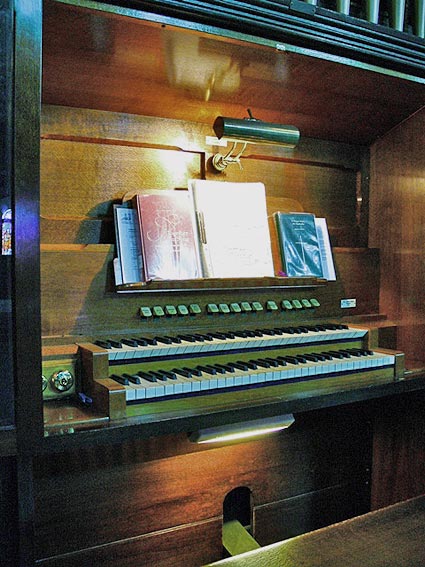Hawthorne Street, Woolloongabba
FIRST ORGAN: B.B. Whitehouse & Co., Brisbane 1912
2 manuals, mechanical action, destroyed by fire 1929
PRESENT ORGAN: Whitehouse Bros, Brisbane 1930
Additions c.1952 Whitehouse Bros & 1986 David Hudd, Brisbane
Alterations 2011 W.J. Simon Pierce, Brisbane
2 manuals, 9 speaking stops, tubular-pneumatic action
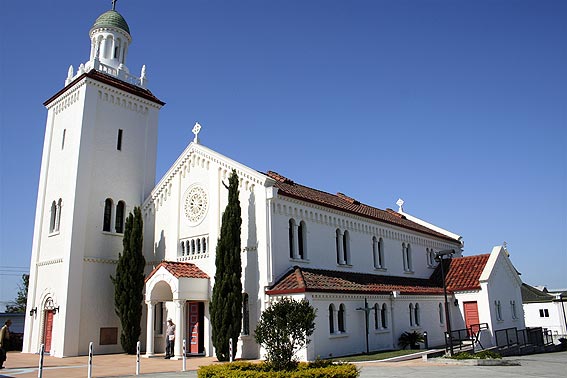
Holy Trinity Anglican Church, Woolloongabba
[Photograph by Trevor Bunning (September 2007)]
Historical and Technical Documentation by Geoffrey Cox
© OHTA 2007, 2010, 2016 (last updated November 2016)
The first regular Anglican services in the Woolloongabba area were held in a room in the Buffalo Hotel on the corner of Ipswich Road and Hawthorne Street in the late 1860s. The property on which the church now stands in Hawthorne Street was donated to the Diocese in 1869 and the first church was erected in 1870.1 The first church, a wooden structure, was blown down during a gale in October 1874 and re-opened on Trinity Sunday 1875. Having survived almost sixty years, it was destroyed by fire on 11 December 1929, by which time plans for a new church were already well advanced.2
The present building was opened on 4 October 1930. Built in the popular Spanish Mission style of the interwar period, with ecclesiastical Romanesque detailing, it enjoys a commanding position over the surrounding area of South Brisbane. It was designed by the Brisbane architect, Eric Ford, of the partnership, Chambers and Ford.3
First Organ (previous church).
There are references to the purchase of an organ for this church from Messrs Paling, Kaye & Jefferies of Brisbane during the year prior to Easter 1879. As the parish organ fund stood at £48 18s 0d, it appears that this was a harmonium.4 There is also a report that an organ was installed in 1908,5 but the first reference to a pipe organ appears in April 1911, when a contract had been signed with B.B. Whitehouse & Co. of Brisbane:
A contract has been entered into between Holy Trinity Church, South Brisbane, and Messrs. B. B. Whitehouse, of George-street, for the erection of a pipe organ. Special provision is being made in order that the organ may be removed into a new church whenever such a building is erected. The site chosen for the organ will also allow of its enlargement at any time without any of the work at present being undertaken having to be interfered with. It is expected that the organ, all of the work for which is being done at the builders' factory in Brisbane, will be ready for use by Christmas. The parishioners are making great efforts to insure that when the organ is played for the first time it shall be free from debt.6
It was not until Tuesday 13 February 1912 that the new pipe organ was opened:
On Tuesday evening a new pipe organ, erected by Messrs. B. B. Whitehouse and Co., will be opened in Holy Trinity, Merton-road, South Brisbane. A recital will be rendered by Mr. Chas. Snow, and vocal music by Miss Vera Parker and Mr. Ernest Pillar. The organ which contains all the latest improvements, is stated to be of an exceptionally sweet tone. All the work has been done in Brisbane.7
A photograph purporting to depict the organ appeared in The Brisbane Courier more than a week later,8 but the casework appears different from that in another photograph depicting the church interior.

Interior of the first Holy Trinity Anglican Church, Woolloongabba
[Photograph from Mark Norton, The "Trinity Chronicles"(1980), opposite p. 28;
Original held in the Anglican Archives, Brisbane]
It appears that the photograph in The Brisbane Courier actually depicts the organ built in December 1910 for the South Brisbane Congregational Church.9 There were several organs of similar appearance built by B.B. Whitehouse & Co. around this time, all comprising a central flat and two angled towers with decorative braces. Only one of these has survived intact: the one built for Holy Trinity Church, Mackay in 1911, now at All Hallows' Convent, Brisbane. The position of the rail over the central flat was below the decorative braces at both Holy Trinity, Woolloongabba (February 1912) and on the organ now at All Hallows' (October 1911), whereas it was above the decorative braces at the South Brisbane Congregational Church (December 1910) and at the Wooloowin Methodist Church (April 1911). Like the organ now at All Hallows', the Woolloongabba organ appears to have had a box-style console, and its specification was probably very similar to those of the organs at All Hallows' Convent or the South Brisbane Congregational Church.
There are records that the Wooloongabba organ was tuned regularly by Whitehouse Bros from at least 1922 onwards.10 Few details of this instrument have survived other than that it comprised two manuals, was handblown, and that the action was mechanical. It was destroyed along with the church itself in December 1929.11
Present Organ.
The present organ at Holy Trinity Church was built in 1930 for the new building by Whitehouse Bros of Brisbane at a cost of £560.12 The blower was moved to a new position in September 1938,13 and two stops (Gt. Stop Diapason 8ft & Gt. Flute 4ft) were added around 1952 by Whitehouse Bros.14
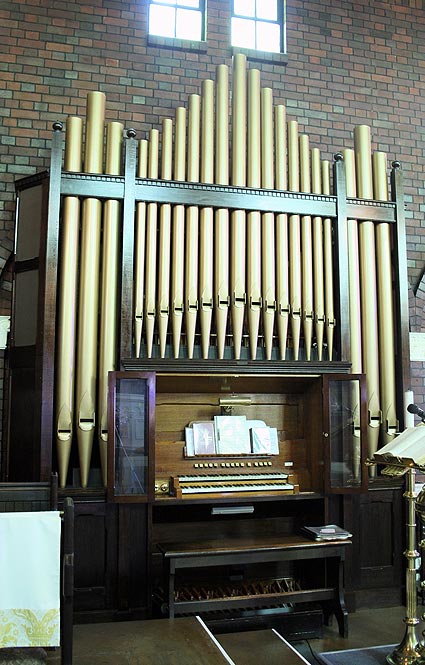
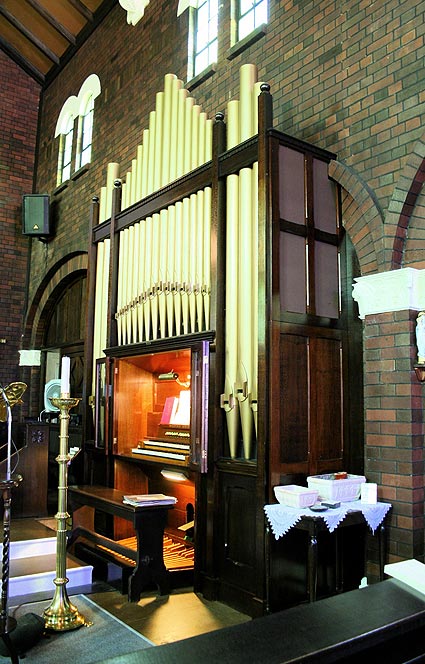
[Photographs by Trevor Bunning (September 2007)]
This was one of the standard small two-manual Whitehouse pneumatic-action organs of the time, the specifications of which varied little over the four decades from c.1910 onwards. This organ, along with that at St John's Presbyterian Church, Annerley, was one of the first to include the arrangement whereby the Swell string stop was duplexed on the Great using the name "Salicional".15
| GREAT Open Diapason Salicional Stop Diapason Flute SWELL Violin Diapason Gedact Echo Gamba Oboe PEDAL Bourdon COUPLERS Swell to Great Swell to Pedal Great to Pedal Swell Octave to Great Swell Sub to Great |
8 8 8 4 8 8 8 8 16 |
[from Swell] [c.1952] [c.1952] [gvd bass] [gvd bass ?] [Tenor C] |
Tremulant (general)
Attached stop-key console
Radiating concave pedalboard
Balanced swell pedal
Tubular-pneumatic action.16
The stop keys are of the triangular-block type, believed to emanate from Thomas Harrison of London.
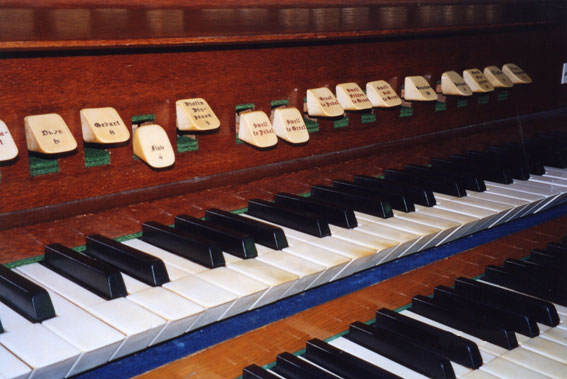
[Photograph by Geoffrey Cox (September 2007)]
Tonal revisions made in 1986 by David Hudd comprised the addition of the Gt. Principal 4ft (in the position formerly occupied by the Flute 4ft), the addition of the bottom octave of the Sw. Oboe 8ft (which had formerly extended only to Tenor C) and the relocation of the Flute 4ft to the former position of the Salicional (which was removed), thus making it available on both manuals. The original chests and action (tubular pneumatic) were retained.17
The organ was completely overhauled in 2001 by W.J. Simon Pierce, with tonal adjustments to increase the power of the instrument: The scale of the Swell Gedact 8ft and Flute 4ft were increased by adding two new bottom notes, and the 1952 Great Stop Diapason was replaced with a new Stopped Diapason of larger scale. The latter was placed in storage with a view to possible re-deployment as a Great Flute 4ft. The Great soundboard was moved forward and the console recessed into the instrument, with new Silky Oak side panels provided to match the existing casework.18
The organ suffered water damage during a freak storm on 27 November 2014, and the Great Organ was rendered unplayable.19 The pneumatic chests and actions to the Great were fully repaired in 2016 by Ian D. Brown & Associates of Ballina. At the same time, the electric motor which had burnt out was removed from the blower and repaired.20
